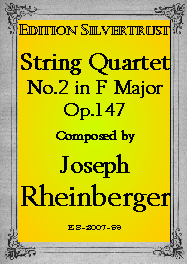Presents
Joseph Rheinberger
String Quartet No.2 in F Major, Op.147
 Today, Joseph
Gabriel Rheinberger (1839-1901), who was born in Vaduz, the capital of Liechtenstein
is chiefly remembered as the most accomplished writer of fugues after Johann
Sebastian Bach.
At the age of 5, young Joseph was given piano and organ lessons from a local
teacher. His talent was immediately discovered and was of such a substantial
nature that with the help of a scholarship he was sent to the Royal Conservatory
in Munich where he studied with Franz Lachner, one of Schubert’s close friends
and an important composer in his own right. Rheinberger, who remained in
Munich for the rest of his life, was in great demand as an organist and choral
master. He eventually became conductor of the important Munich Choral Society
and served as voice coach at the Royal Opera where he got to know Wagner. He
also taught at the Royal Conservatory where he held the position of Professor of
Composition for nearly 40 years. During
his life time Rheinberger was a much respected composer, generally ranked after Brahms
and Wagner as the most important living German composer. Furthermore, he
was also generally regarded as the leading teacher of composition. Among his many students were Humperdinck, Wolf-Ferrari, George
Chadwick (whose quartets we are publishing), Robert Kahn and Wilhelm Furtwangler.
Today, Joseph
Gabriel Rheinberger (1839-1901), who was born in Vaduz, the capital of Liechtenstein
is chiefly remembered as the most accomplished writer of fugues after Johann
Sebastian Bach.
At the age of 5, young Joseph was given piano and organ lessons from a local
teacher. His talent was immediately discovered and was of such a substantial
nature that with the help of a scholarship he was sent to the Royal Conservatory
in Munich where he studied with Franz Lachner, one of Schubert’s close friends
and an important composer in his own right. Rheinberger, who remained in
Munich for the rest of his life, was in great demand as an organist and choral
master. He eventually became conductor of the important Munich Choral Society
and served as voice coach at the Royal Opera where he got to know Wagner. He
also taught at the Royal Conservatory where he held the position of Professor of
Composition for nearly 40 years. During
his life time Rheinberger was a much respected composer, generally ranked after Brahms
and Wagner as the most important living German composer. Furthermore, he
was also generally regarded as the leading teacher of composition. Among his many students were Humperdinck, Wolf-Ferrari, George
Chadwick (whose quartets we are publishing), Robert Kahn and Wilhelm Furtwangler.
String Quartet No.2 was composed in 1886. In the joyous opening theme to the first movement, Allegretto, the first violin carries the melody against important rhythmic elaboration in the other parts. The Adagio which follows is quite peaceful until the middle section (where our sound-bite begins) when a more passionate second theme appears. The main theme to the third movement, Tempo di Menuetto—moderato, though it has a slight drag, is still full of swing. In the highly unusual trio section, the viola gives forth the melody in its lower register while the first violin plays a rapid series of triplets high upon its e string creating a tremolo effect. In the finale, Introduction & Fugue, Rheinberger creates what is surely one of the best fugues ever written for string quartet. The powerful and dramatic opening chords of the introduction (Adagio non troppo) immediately takes the listener’s attention. However, the music then moves forward in a quieter, reflective manner, reminding one of Late Beethoven. Rheinberger’s large scale fugue for quartet, though entirely different in mood from Beethoven’s, nonetheless equals the virtuosity and compositional perfection of the Grosse Fuge. The fugue starts quietly in the 2nd Violin. The theme is merely four notes, a “cuckoo” motif, a call and an answer. Yet from this tiniest of beginnings great things spring. On this foundation, Rheinberger creates a magnificent edifice—437 measures long—in which his incredible compositional ability and skill is clearly displayed as he gives a lesson in the art of fugue. One is hardly aware of it because the thematic material is melodically attractive and rich enough to distract throughout much the fugue. Finally in the coda, the fugue is brought up short and interrupted with the opening 8 measures of the Adagio from the introduction. A Con fuoco coda, based on the viola’s entrance in the opening measures of the fugue, immediately follows and leads to a powerful close.
This quartet is among the best of those written during this period. It belongs in the repertoire and in the concert hall and can also be recommended to amateurs.
Parts: $24.95
Parts & Score: $31.95